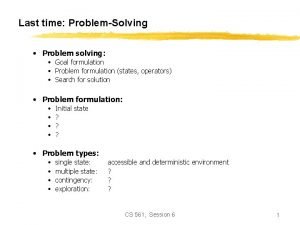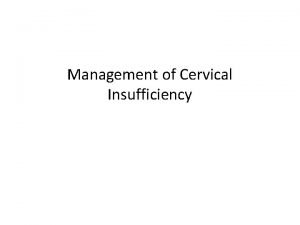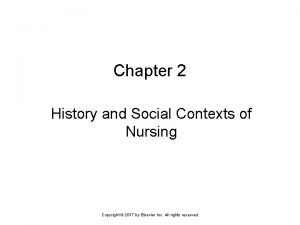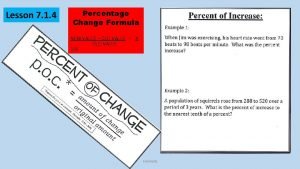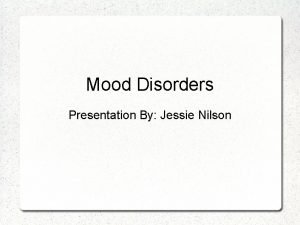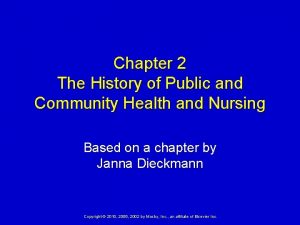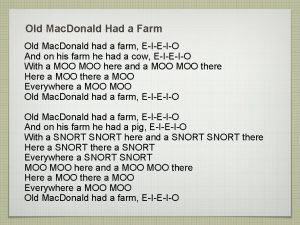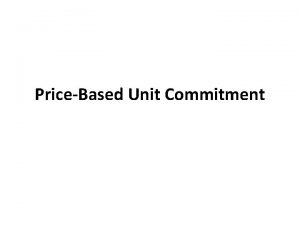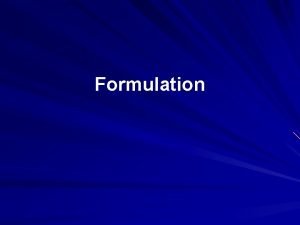FORMULATION Yvonne Edmonstone Jessie Mac Donald The science
























- Slides: 24

FORMULATION Yvonne Edmonstone Jessie Mac. Donald “The science of formulation must be combined with art. Something vital is lost if the formulation does not capture the essence of the case. ” Denman

Case Formulation • Initially developed for psychodynamic approaches • Shown to be a replicable procedure • General psychiatric formulation includes genetic, medical, psychological, phenomenological & social components “Seeing the bigger picture” • At its simplest “Why has this individual become ill in this way at this particular time? ” • Formulation = “systematic description” Hypothesis about the psychological mechanisms underlying the patient’s current difficulties.

Why Formulate? 1. Diagnosis alone is unlikely to be sufficient. Formulation gives more information as it focuses on more than just symptoms. It looks at why the problem occurred as well as what the problem is. 2. Helps in developing an understanding of the patient and their difficulties 3. Looks at what early experiences may have contributed to current difficulties.

Why Formulate? (Cont. ) 4. Provides an individualized understanding of why problems have arisen and what is maintaining them. Looks at current stressors. 5. Helps in understanding relationships between problems. Looks at underlying beliefs, rules, standards & expectations. 6. Assists in choosing which problems should be tackled first i. e. choosing intervention point

Why Formulate? (cont. ) 7. Guides selection of most appropriate treatments i. e. choosing intervention strategies like homework to improve treatment outcome. 8. Helps to predict patient’s behaviour i. e. likely response to treatment and potential difficulties 9. Helps to predict and manage setbacks in therapy.

Why Formulate? (cont. ) 10. Gives the patient a rationale for therapy 11. Helps in understanding and working on relationship difficulties 12. Assists collaboration particularly if done as a joint venture.

Formulation – other benefits • May help reduce the length of treatment • Helps deal with blocks and difficulties that arise • Allows therapist to treat problems not come across before

Covert & Overt Difficulties Persons 1989 Covert difficulties in a formulation are the patient’s core beliefs, conditional beliefs and compensatory strategies. Life events interact with covert difficulties to cause and maintain overt difficulties.

Formulatation – How? 1. Begin at “overt” level of difficulty i. e. What patient presents with? Why patient seeks treatment? Make an exhaustive list of problems –cognitive, behavioural, physical & emotional Physiology Emotion Behaviour Thoughts Environment

Formulation – How? (cont. ) 2. Move to “covert” difficulties i. e. underlying psychological mechanisms such as vulnerabilities and coping strategies. What do all these problems have in common? E. g. beliefs, skill deficits or behavioural patterns which help explain difficulties Thoughts Compensatory strategies Assumptions Early Experiences Beliefs Current Experiences

Formulation – How? (cont. ) 3. What is the meaning of the chief complaint? 4. What were the critical incidents precipitating the crisis leading to the presenting problems? 5. What are the factors that have lead this client to develop this problem at this time? 6. What significant life events have occurred?

Formulation How? (cont. ) 7. What are the common themes of automatic thoughts? 8. What are the principal themes from the past? 9. What early experiences may have affected the formation of beliefs? 10. What early maladaptive schemas might account for this story?

Formulation – How? (cont. ) 11. Are there hints about the kinds of underlying assumptions ? 12. What kinds of conditional beliefs are held? 13. What are the schemas about self, others and the world? 14. Can you propose an underlying mechanism that can account for all the problems on the list? 15. What further evidence is needed to test out the formulation?

Generic Formulation (Eden Unit) Patient’s name and date of birth Date of Formulation PREDISPOSING FACTORS TO DO/ DISCOVER We usually draw a genogram here Matters of fact, further We insert all the info from multidisciplinary assessments investigation, and the subsequent discussion in ‘bullet point’ form in conjecture etc the appropriate boxes PERPETUATING FACTORS PRECIPITATING FACTORS O f this and any previous episodes, listed here in order Alas, much stuff from other boxes also goes here – even stuff from’strengths’ can cut both ways! PRESENTING PICTURE Including co-morbidities PROTECTIVE FACTORS AND STRENGTHS Including individual, interpersonal, family supports, acceptance of treatment etc

Formulation: CBT Physiology Emotion Behaviour Thoughts Compensatory strategies Assumptions Early Experiences Beliefs Current Experiences

Formulation IPT (Bio-Psycho-Social Model) Biological Factors Genetics Medical illnesses Medical treatments Substance use Social factors Intimate relationships Social support Unique Individual Interpersonal Crisis (Focus) - Grief - Dispute - Transition - Sensitivity Interpersonal Distress Diagnosis Psychological Factors Attachment style Temperament Cognitive style Coping mechanisms

DBT Formulation Background Factors CURRENT PROBLEMS Therapy Interfering Life Threatening Core Beliefs about Self Quality of Life Core Beliefs about Others EMOTIONS (that interfere with a more skilful response) OVERDEVELOPED BEHAVIOURS UNDERDEVELOPED BEHAVIOURS Goals Life threatening Behaviours Therapy Interfering Behaviours Quality of Life

Formulation – Test it! • Does it make sense? • Do the early life experiences explain the formation of the schemas held? • Is the formation of conditional beliefs explained? • Does the impact of the critical incident make sense in relation to the rest of the formulation? • Do the presenting symptoms fit? • Does patient (& supervisor) agree with formulation?

Formulation – What next? • Complete formulation and agree therapy goals • Make treatment plan - An accurate formulation will assists selection of appropriate treatment strategies / interventions • Helps to predict how patient will respond • Consider obstacles to treatment e. g. what impact do patient’s beliefs, attitudes, personality etc have on treatment • May help to predict potential difficulties and suggest how to deal with them.

Case Formulation Exercise • AB is 23 yr old woman “Depressed several months” “Binging and vomitting increasingly frequently” • 2 nd Year nursing student – struggling with recent clinical placement • Some anxiety about completing course and finding work – describes self as “Perfectionist” • Boyfriend 6 mths – Mechanic • Parents separated – Dad alcohol problems • Living at home with mother and brother

Formulation: Exercise Physiology Emotion Behaviour Thoughts Compensatory strategies Assumptions Early Experiences Beliefs Current Experiences

Case Conceptualisation worksheet “OVERT” Tired Lacking motivation Emotion Down / Depressed Worried/Anxious Physiology Losing weight (BMI 18) Difficulty concentrating Behaviour Withdrawal & avoidance Rarely go out except to work Restricting, binging and vomiting Thoughts “I’m rubbish, no good at this, will never make a nurse” “Mustn’t worry Mum” “Don’t want to see other people. Don’t do anything, nothing to talk about” “Not pretty – too fat – expect boyfriend will dump me” Environment Difficult, busy training placement Financial worries Parental dispute New relationship

Case Conceptualisation worksheet “COVERT” Compensatory strategies Avoidance & Perfectionism Assumptions Others look down on me because I’m not god enough I should do better I cant afford to make any mistakes if I am going to succeed in nursing If I was slim and pretty, then my relationship would last I mustn’t upset Mum as she has too much to deal with already Past Experiences Parents separated Dad alcoholic Ashamed of family Beliefs I’m useless I’m no good I’m a failure Others are better than me Current Experiences Busy training placement Financial worries Parental dispute New relationship

Further Reading • Case Formulation in Psychotherapy: Revitalizing Its Usefulness as a Clinical Tool Sim, Kang; Kok Peng Gwee; Bateman, Anthony Academic Psychiatry; Jul/Aug 2005; 29: 289 – 299 • The Quality of Psychotherapy Case Formulations: A Comparison of Expert, Experienced, and Novice Cognitive–Behavioral and Psychodynamic Therapists Tracy D. Eells, Kenneth G. Lombart, Edward M. Kendjelic, L. Carolyn Turner, and Cynthia P. Lucas Journal of Consulting and Clinical Psychology 2005, Vol 73, No. 4, 579– 589
 Dr edmonstone
Dr edmonstone Why problem formulation follow goal formulation
Why problem formulation follow goal formulation Mc donald 2017
Mc donald 2017 Cervix
Cervix Chromosomal abnormalities miscarriage
Chromosomal abnormalities miscarriage Regla de mcdonald
Regla de mcdonald Old macdonald had a farm français
Old macdonald had a farm français Origins of macbeth
Origins of macbeth Mac mac o kok dac
Mac mac o kok dac Mathematics ____ my favorite subject.
Mathematics ____ my favorite subject. Jessie arbogast 2020
Jessie arbogast 2020 Jesse emily schofield
Jesse emily schofield Jessie sleet scales
Jessie sleet scales Jessie arbogast
Jessie arbogast Jessie kurtz
Jessie kurtz Jessie estimates the weight of her cat
Jessie estimates the weight of her cat Dgv mentor
Dgv mentor Statdx elsevier
Statdx elsevier Whos for the game jessie pope
Whos for the game jessie pope Jessie nilson
Jessie nilson Jessie moreau
Jessie moreau Jessie
Jessie Dr jessie cheung
Dr jessie cheung Jessie sleet scales
Jessie sleet scales Jessie carrillo
Jessie carrillo

